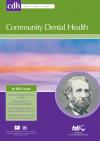Community Dental Health

- Cover Date:
- June 2009
- Print ISSN:
- 0265 539X
- Vol:
- 26
- Issue:
- 2
Seroepidemiology of hepatitis C antibodies among dentists and their self-reported use of infection control measures
Objectives. To determine the prevalence of hepatitis C virus (HCV) antibodies among dentists graduated from various countries and assess the use of infection control measures in their dental practice. Research design. The study included 301 Israeli dentists who attended an annual dental conference. Participants filled out a structured questionnaire regarding demographic (age, gender, number of siblings, number of children) and occupational characteristics. Venous blood was examined for presence of HCV antibodies by enzyme immunoassay and confirmed by a third generation line immunoassay, which assesses antibodies to HCV-core antigens (INN-LIATM HCV Ab III update, 100% sensitivity, 100% specificity). Results. The prevalence of HCV antibodies among Israeli dentists was 1/301 (0.33%), similar to the prevalence range (0.1-0.5%) among the general Israeli population. The studied population included dentists (30.6%) who immigrated from Asia, Eastern Europe and the former USSR, where HCV prevalence ranges from 3.1% to 26.5%. Dentists routinely used gloves (99.6%), gown (93.3%), autoclaves (90.3%), dry heat (29.1%) and mask (81%). Dentists who graduated after 1985 used a mask or gown significantly more often than dentists who graduated before 1985 (p<0.001 and p=0.004, respectively). Conclusion. It seems that dentists who usually adhere to basic infection control measures are not at an increased risk for HCV.
Key words: Dentist, hepatitis C virus, infection control
- Article Price
- £15.00
- Institution Article Price
- £
- Page Start
- 99
- Page End
- 103
- Authors
- M. Ashkenazi, N. Fisher, L. Levin, M. M. Littner
Articles from this issue
- Title
- Pg. Start
- Pg. End
- Editorial - NHS dental care and the issues of public service ethos, governance, accountability and probity
- 66
- 68
- Racial and ethnic differences in a regular source of dental care and the oral health, behaviors, beliefs and services of lowincome mothers
- 69
- 76
- Association of urgent dental care with subjective oral health indicators and psychosocial impact
- 77
- 83
- The use of conversation mapping to frame key perceptual issues facing the general dental practice system in England.
- 84
- 91
- Seroepidemiology of hepatitis C antibodies among dentists and their self-reported use of infection control measures
- 99
- 103
- Differences in oral health behaviour between children from high and children from low SES schools in the Netherlands.
- 110
- 115
